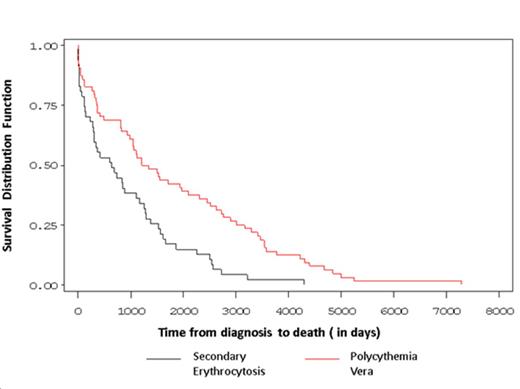Abstract
Background
Life expectancy of patients with Polycythemia Vera is reduced compared with the general population. History of thrombosis has been found to be the main predictor of death in this disease. Factors like older age, leukocytosis and thrombosis have been shown to increase the risk of mortality. Secondary polycythemia on the other hand is largely an unknown entity. This study aims to compare the various prognostic and predictive factors for mortality between primary polycythemia vera and secondary polycythemia group.
Patients and Methods
Patients >=18 years of age seen at a Montefiore outpatient clinic and/or inpatient setting from 1998 to 2014 with a diagnosis of polycythemia, either primary or secondary, who have died, were included. This was done with the help of Clinical Looking Glass software after obtaining Institutional Review Board approval. Patients were stratified by race and ethnic groups. Primary polycythemia was confirmed by evaluating each medical record in detail, lab values including erythropoietin level, JAK2 mutation status and bone marrow biopsy reports. Other laboratory results evaluated were WBC, Hg, platelets, hemoglobin, MCV, RDW and albumin.
Morbidity including history of arterial/venous thrombosis and mortality data were obtained to compare survival and identify potential predictors of morbidity and mortality.
All analyses were conducted using STATA statistical software. Baseline characteristics were compared using two sample tests of proportions and Student t-tests for means. Kaplan-Meier curves were constructed to compare survival by various subgroups. Hazard ratios were calculated using multivariate Cox regression models to adjust for co-variates to compare mortality risk and identify potential independent predictors of mortality.
Results
Total of 112 patients with polycythemia, who have died within the period of 1998-2014, were identified. 64 (57%) patients had primary polycythemia and 48 (43%) patients were diagnosed with secondary erythrocytosis. The median age for diagnosis was 63 years for secondary and 72 years for primary. The commonest causes of secondary polycythemia in these patients were severe COPD, congenital heart disease and severe pulmonary hypertension.
In patients with polycythemia who died within the specified period of 16 years, median time to mortality from diagnosis was significantly shorter (p value: 0.004) in secondary polycythemia (21.1 months or 634 days) compared to primary polycythemia group (42.6 months or 1277 days). Figure 1 illustrates the duration in survival from time to diagnosis between the two groups. There was no significant difference amongst the white, black and Hispanic populations in the 2 groups.
23 (38%) patients in the primary polycythemia group had venous/arterial thrombosis compared to 6 (5%) in the secondary group. This difference was also significant with a p value of 0.005.
As expected, erythropoietin was lower in primary compared to secondary group. Also, WBC and platelet counts were significantly higher in primary polycythemia versus secondary polycythemia group.
An interesting finding was that the mean albumin was significantly lower in the secondary polycythemia (3.3) patients who died compared to the primary polycythemia patients (3.8) with a p value of 0.004.
Conclusions
Our findings demonstrate that patients who die with secondary erythrocytosis have shorter time to death from diagnosis compared to primary polycythemia vera. This is most likely due to the worse prognosis associated with the underlying disease causing erythrocytosis. Even though, secondary polycythemia is not generally treated in the same way as primary polycythemia, development of increased hemoglobin should be taken as a cautionary sign for these patients as this is likely a strong predictor of mortality. Moreover, patients who died with secondary polycythemia have lower albumin levels compared to primary polycythemia vera patients. This signifies the importance of albumin levels as a prognostic factor in patients with secondary erythrocytosis. This is a novel study which compares primary and secondary polycythemia and helps to delineate various prognostic factors in these disease groups.
Kaplan Meier curve: Primary Polycythemia Vera vs Secondary Erythrocytosis
No relevant conflicts of interest to declare.
Author notes
Asterisk with author names denotes non-ASH members.


This feature is available to Subscribers Only
Sign In or Create an Account Close Modal